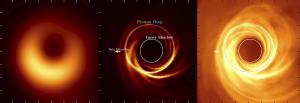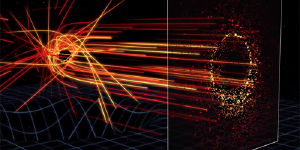Blog
Dark Horizon
4 June 2021
 Andrew Chael, et al
Andrew Chael, et alIn 2019 the Event Horizon Telescope (EHT) gave us the first direct image of a black hole. On one hand, the image it produced was rather unimpressive. Just a circular blur of light surrounding a dark central region. On the other hand, subtle characteristics of the image hold tremendous information about the size and rotation of the black hole. Most of the details of the black hole image are blurred by the limits of the EHT. But the next generation EHT should provide a sharper view, and could reveal the dark edge of a black hole’s event horizon.1
 Center for Astrophysics, Harvard & Smithsonian
Center for Astrophysics, Harvard & SmithsonianA black hole doesn’t emit light itself. Any light that crosses its event horizon is forever trapped. The glowing ring we see in the EHT image of M87* is caused by the background radio glow of gas and dust surrounding the black hole. Some of that light passes very close to the black hole and is gravitationally lensed in our direction. The closest limit that light can graze the black hole and reach us is known as the photon ring.
If we could observe the black hole perfectly, the photon ring would be a thin bright line. Some of the light from the photon ring is scattered before it reaches us, and combined with the resolution limits of the EHT this creates the blurred image we see. But the next generation EHT will have a higher resolution and will be able to capture images in a shorter period of time. This will allow detailed images not just of M87*, but also of the supermassive black hole in our galaxy.
 George Wong (UIUC) and Michael Johnson (CfA)
George Wong (UIUC) and Michael Johnson (CfA)One of the things the ngEHT could reveal is multiple layers of lensed light. Most of the light we see surrounding the black hole is that of the photon ring. That is, the strongly lensed light that grazed the black hole. But some light will make a full loop around the black hole before heading our way, and a small amount will make multiple loops. Each type of photon path creates a different layer of light ring around the black hole. If we can pull apart these layers, we will better understand the nature of gravity near a black hole.
And, as a recent paper on the arXiv shows, the ngEHT could also help us probe a black hole’s event horizon itself. The dark central region of the M87* image isn’t that of the event horizon. It’s just a shadow of the black hole caused by the photon ring. But within the central region, there should be an inner shadow. A shadow of the event horizon. As this recent work shows, this inner shadow wouldn’t be a simple circle. Its shape would depend on the size and rotation of the black hole.
The gravitational field near a black hole is so strong that it distorts not only the glow of the photon ring but also the shadow of the event horizon. So while the event horizon is truly spherical, our view of the event horizon can be distorted by the black hole’s gravity. In this latest work, the team shows how we might be able to observe both the photon ring and the inner shadow. By comparing the two we would gain a deep understanding of black hole dynamics, including information about how light and matter are captured by a black hole.
In time, we might finally be able to see the dark shadow of gravity itself.
Andrew Chael, et al. “Observing the Inner Shadow of a Black Hole: A Direct View of the Event Horizon.” arXiv preprint arXiv:2106.00683 (2021). ↩︎